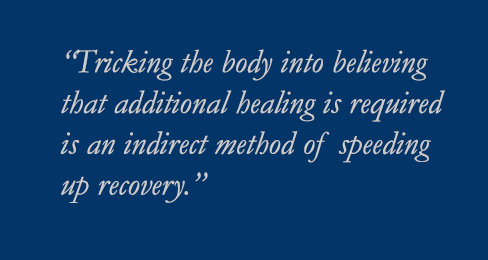Many traumatically caused injuries, particularly those to the back and neck, create disproportionate symptoms. That’s because such injuries result in both clinical and subclinical harm. Clinical harm is that which is capable of being easily diagnosed: abnormal findings on physical exam or as revealed by diagnostic tests such as x-ray or MRI. Subclinical harm resists detection, is invisible, and often persists indefinitely. Many who have suffered back or neck injuries are forced to endure chronic pain notwithstanding any number of “normal” clinical findings.
Many standard treatments for back and neck pain are designed not to harm or aggravate the injured area. One new treatment that’s being studied, however, promotes healing by inflicting a localized trauma to the injured area.
Dextrose Prolotherapy. In a recent article, the authors describe the efficacy of a treatment known as “Dextrose Prolotherapy.”1 This treatment involves injecting small amounts of dextrose, an irritant solution, at and near the area of pain, triggering a healing response. The authors write that the treatment “is a nonsurgical regenerative injection technique that introduces small amounts of an irritant solution to the site of painful and degenerated tendon insertions (entheses), joints, ligaments, and in adjacent joint spaces during several treatment sessions to promote growth of normal cells and tissues.”
The authors describe how healing is promoted by injecting dextrose at the site of injury: “Hypertonic dextrose solutions act by dehydrating cells at the injection site, leading to local tissue trauma, which in turn attracts granulocytes and macrophages and promotes healing.” Noting the effect of this treatment on various conditions, the authors conclude:“Overall, dextrose prolotherapy has been demonstrated to be efficacious and should be considered as a treatment for pain and dysfunction associated with chronic musculoskeletal conditions, particularly tendinopathies and OA [osteoarthritis].”
Healing by harming. Healing by harming is not a new idea. But the key is to administer precisely the right amount of harm—large enough to trigger a healing response yet small enough for the body easily to repair. If too much harm is administered, the condition is made worse; if not enough, the treatment will not work. (Many, by the way, will readily see the applicability of this technique to other areas—everything from education to psychology, from politics to economics—but the frequently used strategy of carrot and stick, of reward and punishment, must be used judiciously, does not always apply, and in some instances will tend to make matters worse…)
The notion of re-injuring an already injured part of the body to encourage healing seems counter-intuitive. It would seem healing would be optimized by avoiding any new insult or injury to an already existing area of harm. But medical interventions do not heal unless they engage and activate the body’s natural healing response. Tricking the body into believing that additional healing is required is an indirect method of speeding up recovery. In the future perhaps we will see treatments for other conditions, such as cancer or heart disease, utilize the same process.
1R. Hauser, et al., A Systematic Review of Dextrose Prolotherapy for Chronic Musculoskeletal Pain, Clinical Medicine Insights: Arthritis and Musculoskeletal Disorders, 9 Clin Med Insights Arthritis Musculoskelet Disord., Pgs. 139–159 (2016).




